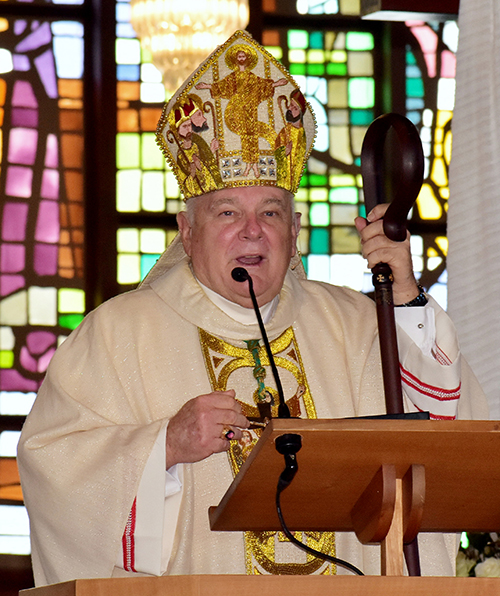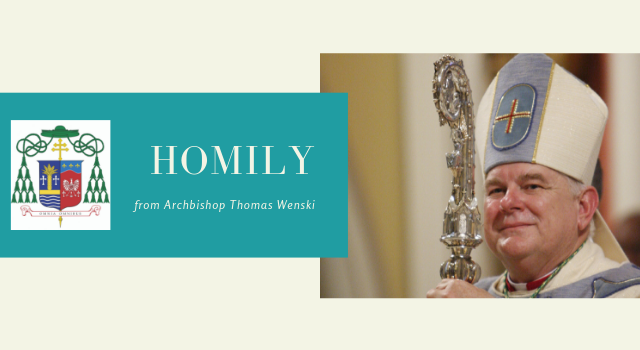By Archbishop Thomas Wenski - The Archdiocese of Miami
Archbishop Thomas Wenski preached this homily Nov. 22, 2020, at a Mass marking the 60th anniversary of Nativity Parish in Hollywood.
I am very happy to celebrate with you and with your pastor, Father David Zirilli, and the other priests and deacons of the parish, 60 years of the founding of this parish. Who was here 60 years ago? Raise your hands. 60 years might not seem like a long time for a Church that is almost 2,000 years old; but here in this still young archdiocese, 60 years is certainly something to celebrate – even in this most unusual year of 2020.

Photographer: JIM DAVIS | FC
Archbishop Thomas Wenski declared Nativity Church an "oasis" for rest and renewal.
The word, parish, is derived from the ancient Greek – pa-roi-ki-a -; the Spanish, parroquia, is much closer to the original Greek than its English equivalent. It meant a sojourn in a foreign land, or a community of sojourners. And, so when the Hebrew Scriptures were first translated into Greek, pa-roi-ki-a was used to describe the Israelites as they journeyed through the desert on their way to the Promised Land. As Catholic Christians, we know that here on this earth we have no lasting dwelling place, for our citizenship is in heaven, our true Promised Land.
Our parishes, where the communities of sojourners meet, are then like way stations or rest stops along our pilgrim way as we journey towards that kingdom where Jesus reigns forever.
And Nativity, of course, is much more than just a simple rest stop: It is truly an oasis where we find rest, yes, but also renewal as we travel in a world that, because it increasingly pretends that God does not matter, can sometimes appear as a dry and arid place, a desert as foreboding as the Sinai desert must have appeared to the Hebrews, the original sojourners.
Today, we also celebrate the Last Sunday of our liturgical year – and this week will be observed as the last week in Ordinary Time. Yet, this Sunday is in a sense far from ordinary, for today we celebrate the Solemnity of Christ the King.
At first glance, we might be tempted to regard such a feast as some sort of relic of a long past era. After all, today, in our postmodern age, we are not governed by kings. And kings and queens where they still exist are pretty much symbolic figureheads. And so, we might dismiss today’s liturgy’s acclaim of Christ our King as a bit anachronistic.
And yet the solemnity of Christ the King – as a liturgical institution – is quite recent. It was established not by some medieval pope but by a quite modern day one, Pope Pius XI in 1925.
The pope was not engaging in some flight of fantasy; in fact, adding the feast of Christ the King was rather a thumb in the eye of a world which had already begun to pretend that it could organize itself without God. The October Revolution of 1917 in Russia had already been consolidated and with it, under the spell of radical secular ideologies of both the right and the left, the 20th century was well on its way of becoming the most violent, the most murderous in history.
This was the climate in which this feast was born – and perhaps what motivated the pope to establish this feast was a revolution in Mexico. There, a revolutionary government was established which persecuted the Church – and not just bishops and priests, but the entire community of the baptized – and it persecuted the Church with a ferocity that paralleled what was already happening in Soviet Russia. There, in Mexico, thousands were killed in the name of freeing people from religious “superstition." This era in our southern neighbor’s history is well depicted in a Graham Greene novel, "The Power and the Glory," in which the main character was a flawed priest who could not escape execution. But this was not just the stuff of novels – it was real.
Led before firing squads, many died shouting: “Long live Christ the King,” "Viva Cristo Rey!" The Church remembers these Mexican martyrs – and tomorrow we observe the feast day of Padre Miguel Pro and his companions. These martyrs and the millions who died in the successive holocausts of the 20th century remind us that when we pretend to organize the world without reference to God and his truth, we end up organizing the world against man himself.
And so when many thought that God should be exiled from the affairs of the world – or at least marginalized to the point where he didn’t really matter – Pope Pius XI, in establishing this feast day, wished to remind us that Jesus is the world’s true ruler and judge.
While the establishment of the feast is recent, the content of what we celebrate today is indeed quite old – indeed it is as old as Christianity. To say that “Christ reigns” is the equivalent of what we say in our profession of faith: “Jesus is Lord.”
Jesus is King – but unlike any other – for him to rule is to serve; he is a shepherd King, who lays down his life for his sheep. He is King – but his crown is not made up of jewels and precious stones, rather it is a crown of thorns; and his throne is a cross.
In the Gospel reading, Matthew gives us an apocalyptic vision of the Last Judgment – when people of every race, language, and nation will appear before the King. You could say that Matthew gives us a peek at the final exam. Students, wouldn’t that be great if you knew what questions they were going to ask on the test ahead of time?
And that biggest question is the one we will ask, “Lord, when did we see you?” For us to see him in his glory at the end of time we must recognize him in the least, the last and the lost of our brethren. As Mother Teresa of Calcutta would say, we must recognize Jesus in the often-disagreeable disguise of the poor.
For 60 years, Nativity Parish has welcomed God’s pilgrim people. In the ministries of the parish we can find beautiful examples of parishioners carrying out one or more of the corporal and spiritual works of mercy. And, if you continue to do that, you’ll “ace the test” when Judgment Day comes.
Of course, the history of this parish – like any history forged by fallen human beings – is full of lights and shadows. We should not be surprised that the Church which Christ founded to save sinners is – well – full of sinners. Yet, the Church is holy – and she is holy not because of us but because of the Spirit that is given to her. Despite the shortcomings and foibles of her human members, the Church of God has continued to grow here in South Florida – and here at Nativity. At a time when many would want to write off the Church as irrelevant and, in view of the ascendant secularism of our age, would argue that living the faith coherently is not worth the risk of discipleship, the parishioners of Nativity for 60 years, through your time, talent and treasure, you have supported the mission of the Church in the world.
Thanks
to the presence of the Holy Spirit, who could say that these past 60 years have
not been years of grace?
Many have come and gone – and today we lift up
in prayer those pioneers – priests and people – who were here at the beginning
and have gone home to the Lord. But during these 60 years you have built more
than buildings; you have built an oasis of faith, hope and love; you have made a
community where Christ is King.

